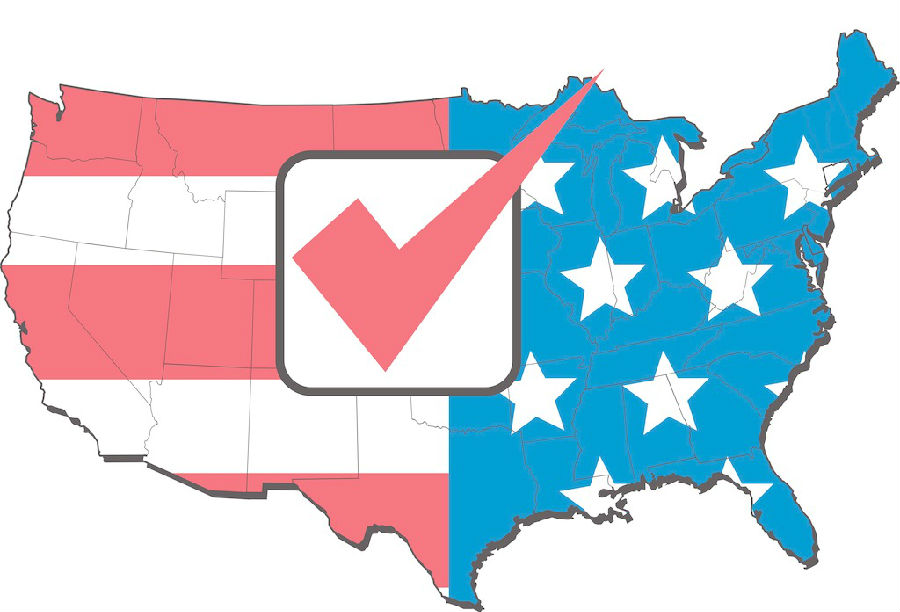Let me go back to the map here talk about the ideas behind it
我們回到之前的這幅地圖,來研究研究它所隱藏的信息
What are the patterns does this map supposedly showing
我們能從這幅圖推測出怎樣的選舉規(guī)律呢
Let's just take the map for a while as a given
假設我們對這幅地圖沒有異議
Let's just say ok we can accept there are red states and blue states
我假設我們接受這些藍色州和紅色州的表現(xiàn)方式
now later, I will try to dismantle that idea and show it's much more complicated
因為等會我要推翻這種規(guī)律,給你們講些更復雜的
but let's just take the stereotype as it exists
現(xiàn)在先把這種規(guī)律當做存在
and let's ask what differentiate the red states and blue states other than voting
讓我們來思考,在這些紅色州和藍色州之間,除了他們支持不同的政黨
are there consistent features that separate this one block of United States from another block
還有什么內在特征使得美國分成了幾個板塊呢?

While certainly as that map I showed you earlier of the Untied States of Canada versus Jesusland
回憶我之前給你們看的那幅Jesusland的地圖
which indicate religious attendance at the national scale is probably the best predictor of voting patterns
暗示我們,宗教也許是一個影響選民投票傾向的全國性因素
so those individuals who attend religious services more than weekly
那些每周至少參加一次宗教活動的民眾
they form 16% of the electorate voted 65% for George Bush
占全體選民的16%,其中有65%把票投給了喬治布什(共和黨)
those attending weekly 60% that's 27% of the electorate
每周一次宗教活動的人中有60%投給布什,他們占了全體選民的27%
a few times a month pretty much divided 51% voting for George Bush that's 14%
那些一個月只參加幾次宗教活動的民眾,有51%投票給布什,他們占全體選民的14%
several times a year now we have a strong Kerry lead
那些一年只參加幾次宗教活動的民眾明顯更傾向于支持克里
42% voting for George Bush
他們當中只有42%的人把票投給喬治布什
and those who never attend religious services 37% voting for Bush
那些從不參加宗教活動的人只有37%支持布什
so this is one of the best predictors of voting behavior
所以,這是影響投票最重要的因素之一
Of course, you can see there would be plenty of people who attend more than once a week or of the other way,
當然,也有很多人即使一周參加一次以上宗教活動
and the same over here
也沒有把選票投給布什
and that's not a total divide
宗教并不是一個絕對的影響因素
We're not talking about 80%,90%
我們講的分化程度并沒有到80%,90%
but we're talking about pretty significant divisions
但這種分化的確已經非常明顯
and we can see this in other data that we can look at
我們還可以來看一些其他數(shù)據(jù)
And here's a map at the level of state if you look at the states it works but not nearly as well as you might expect
這里有一幅州級地圖,你會發(fā)現(xiàn)這些州,可能你原來的語氣不一樣
so we have the least religious states and I should say it's really hard to get this information
我們可以從圖中看到虔誠度最低的州,這里我要提是獲取這些信息是很困難的
Sociologists of religion know that people aren't always completely honest about how often they attend religious service
研究宗教的社會學家知道,對于參加宗教活動頻率這個問題,人們很少完全誠實地回答
and they tend to overestimated
他們總會夸大其辭
So there are a lot of technichs for trying to get a better handle on it
所以為了使數(shù)據(jù)更為真實,他們需要做很多處理
and actually you get quite varying maps they vary quite a bit from one survey to another
所以你經常看到情況不同的地圖,根據(jù)不同調查的數(shù)據(jù)繪制出的地圖總是不太一樣



